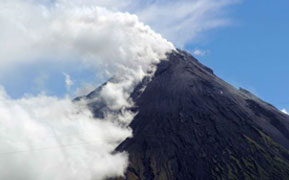I. Introduction
The Philippines is located along the Ring of Fire. As a result, it is a home to many volcanoes. The most famous among our volcanoes is the Mayon Volcano that has erupted last May 7, 2013 while a group of hikers were exploring its beauty.
Who could forget the terrible eruption of Pinatubo Volcano in 1992 after 600 years of inactivity? Based on statistics, in the first five years following the eruption, lahars destroyed the homes of more than 100,000 people. Lahars also covered about 120,000 hectares with sediment to an average depth of about one meter, and floods spread rock debris over a larger area.The eruption also affected other countries as its emissions in the atmosphere lowered the air temperature.
According to the Philippine Institute of Volcanology and Seismology (PHIVOLCS), our country is an ideal site for any volcanic activity. It is therefore, important for us to know how this natural phenomenon happens to reduce the risks and effects it may cause.
II. Learning Competencies/Objectives
In this module, the Learner should be able to:
- differentiate active and inactive volcanoes;
- describe the different types of volcanoes;
- explain what happens when volcanoes erupt; and
- illustrate how energy from volcanoes may be tapped for human use.
III. Pre-/Diagnostic Assessment
A. Choose the letter of the best answer.
1. Which characteristic of magma mainly determines its explosiveness?
- color
- amount
- temperature
- silica content
2. Which of the following characteristics of a volcano depends on its magma emission?
- age
- size
- shape
- location
3. Which of the following factors associated with huge volcanic eruptions may cause the decrease in the Earth’s average temperature for a few years?
- heat
- light
- acid rain
- volcanic ash
4. A thick layer of volcanic ash can be heavy enough to collapse the roofs of buildings because ash ________.
- is solid.
- cannot be blown by winds.
- becomes heavier as it cools.
- consists of tiny fragments of rocks that becomes heavy as they pile up.
5. Which of the following is an active volcano in the Philippines?
- Apo in Davao
- Bud Datu in Sulu
- Isarog in Camarines Sur
- Kanlaon in Negros Oriental
B. Answer the following questions briefly.
6. Aside from Mayon Volcano, name another Philippine volcano that has erupted recently.
7. What causes a shield volcano to be shaped like a broad dome?
8. By what process can a volcanic eruption affect temperatures around the world?
9. Give one positive effect and one negative effect of volcanic eruptions.
10. How is energy from volcanoes tapped as source of electricity?


